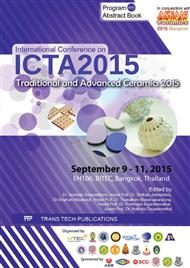p.1
p.6
p.12
p.18
p.23
p.28
p.33
p.39
Analytical Study of Ancient Pottery from the Archaeological Site of Ban Bo Suak from Nan Province, Thailand
Abstract:
Ban Bo Suak pottery sherds were analyzed by using X-Ray Fluorescence, X-Ray Diffraction and Scanning Electron Microscope. The samples JQA.SH1, FQB.SH3, PQC.SH5 and NQD.SH7, showed that phase structure were quartz, tridymite and mullite phase. It was confirmed that sherds were fired at high temperature more than 1000 °C. As a result, they made the body and glaze compacted and turned into stoneware at high temperature. SEM images of surface showed the middle layers between glaze and body for JQA.SH1 and FQB.SH3. The decoration techniques were glazed and slip layer between bodies and glaze.
Info:
Periodical:
Pages:
18-22
Citation:
Online since:
May 2016
Authors:
Keywords:
Price:
Сopyright:
© 2016 Trans Tech Publications Ltd. All Rights Reserved
Share:
Citation:


